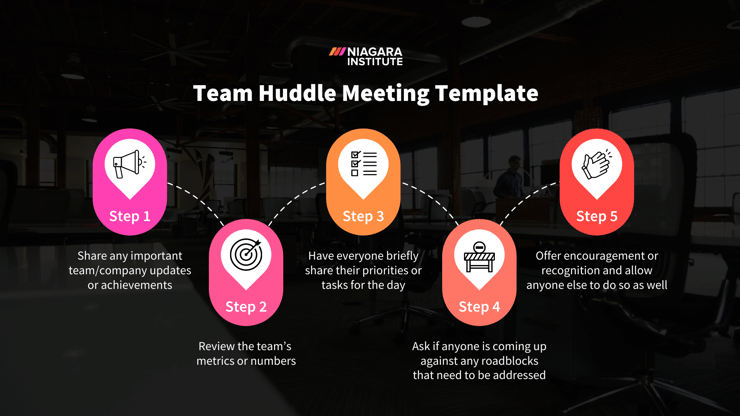7 min read
15 Tips for Running Effective Meetings
We’ve all been there. Attending meetings where the leader drones on, a few people monopolize the conversation, and nothing is actually accomplished....

A lot can happen on your team in the time between team meetings and one-on-meetings with each employee. Urgent requests come in. Workloads shift. Client or executive demands are made. Emergencies happen. For that reason and more, team huddles exist.
If you’re wondering whether your team could benefit from a huddle meeting or not, we’ve answered some of the most frequently asked questions below in hopes that it will help you make the best possible decision for your team.
A team huddle is a brief meeting (less than 15 minutes) that typically occurs at the beginning of the workday or shift between a leader and their team.
The purpose of a team huddle is to share information, reinforce accountabilities, provide encouragement, collaboratively problem-solve, and ensure an alignment between individual priorities and the overarching goal of the team. Unlike weekly or monthly team meetings, daily huddles are high-level and focus on the tactical aspect of the team’s jobs.
As such, the following are typically points of discussion in team huddles:
Huddle meetings with your team should be short and to the point, which means your goal should be to keep them to less than 15 minutes. Rather than scheduling them to start when the workday or shift starts, give everyone some time to settle in, grab a coffee, and check their emails first so that no one feels rushed or unprepared.
The effectiveness of your huddle meetings relies significantly on you - the leader. Your ability to facilitate these meetings, start and stop on time, provide support when called for, and swiftly eliminate roadblocks for employees will impact your employee's willingness to participate and, in turn, your ability to achieve the goal of the meeting.
In addition to that, if you’re employees are dealing with urgent requests, deadlines, or heavy workloads, you might find the effectiveness of your team huddle compromised as employees’ minds are elsewhere and they're anxious to get back to work. In which case, you should use your judgment to decide if delaying or canceling it is best for the team or not.
For everyone to get the most out of your 15-minute huddle meetings, consider setting a few ground rules. By setting ground rules, you establish a standard for everyone involved and make it clear what is expected of them. Here are a few example ground rules to consider implementing:
If huddle meetings are new for your team, it can be helpful to share with them and follow a meeting agenda. Of course, over time, your team will fall into a pattern and find out what works for their unique needs, but in the meantime, this team huddle meeting agenda template will give you a place to start.
Step 1: Share any important team/company updates or achievements
Step 2: Review the team’s metrics or numbers
Step 3: Have everyone briefly share their priorities or tasks for the day
Step 4: Ask if anyone is coming up against any roadblocks that need to be addressed
Step 5: Offer encouragement or recognition and allow anyone else to do so as well

Between the team huddles, one-on-ones, and staff meetings, it is common for leaders to want to host great meetings. Fortunately, like many other aspects of leadership, running effective meetings is a learnable skill. With Niagara Institute’s range of real-time virtual leadership programs and personalized leadership coaching packages, you can learn what you need, when you need it, and become the leader you truly want to be.

7 min read
We’ve all been there. Attending meetings where the leader drones on, a few people monopolize the conversation, and nothing is actually accomplished....

6 min read
Weekly team meetings are a staple in the lives of many teams in the workplace. The purpose is to help ensure the team remains connected to each...

7 min read
We’ve all been part of one from time to time. It’s the dreaded unproductive meeting. If you find that your team meetings could use a refresh, we’ve...